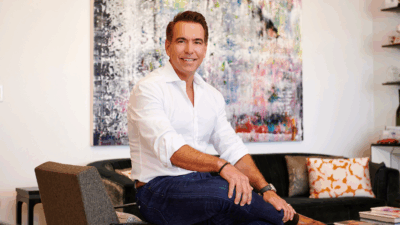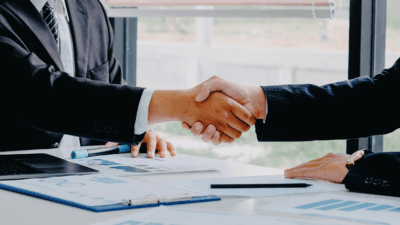Extra Credit: The Shifting World of Private Credit Markets
New fintech disruptors are changing the $7 trillion private credit market right before our eyes. Let’s unpack how we arrived here…

Sign up for smart news, insights, and analysis on the biggest financial stories of the day.
We had the opportunity to interview Nelson Chu, the founder and CEO of Percent, a new fintech platform designed to disrupt the $7 trillion private credit market.
Nelson brings a unique perspective to the inner workings of today’s private credit markets and their massively important role in the global economy. He’s also, obviously, an expert on how Percent is changing the way borrowers go to market and opening an entirely new door to all accredited investors.
Good Credit Karma
When people talk about “The Market,” they almost always mean the stock market. But in many ways, most everyone is much more familiar and much more involved in credit markets…even if they don’t realize it.
As opposed to the less than 60% of Americans who own equities, almost all of us interact daily with credit instruments like auto loans, mortgage payments, and credit cards. Indeed, huge pockets of the economy revolve around assessing consumers’ creditworthiness and their so-called “ability to pay,” meaning card issuers and credit bureaus construct large and complex models that analyze your risk profile in almost real-time. Put simply: when you walk into Target, Bloomingdales, or Best Buy, your FICO score is effectively tattooed on your forehead.
Since the beginning of the modern economy, the availability of credit and cost of lending have both been dictated by the movement of interest rates, and that has played a major role in any discussion of economic health. This year we’ve all gotten a fresh reminder of just how impactful monetary policy and interest rates can be, and just how much power the Federal Reserve has to influence our economic outlook.
If there’s too much credit, known as “loose monetary conditions,” the economy can overheat and we would see things like the current reality of crippling inflation. Too little credit though means that businesses are unable to borrow and expand, and those effects can be equally deleterious.
The History of Private Credit
Formal lending has been around since antiquity.
The first recorded bond was a literal stone discovered in Mesopotamia. It dates back to 2400 B.C. and it served as a type of surety bond. Instead of $100 million+ wire payments, this bond dealt in corn, but the principle was the exact same.
Modern corporate bonds arrived a little later, and were first used to finance the Dutch East India Company in 1623. The US Federal Government first raised debt in 1775 to pay for the Revolutionary War. In hindsight, that might have been one of the highest rates of return in the history of credit.
Now let’s fast forward to the 1970s and the invention of both shag carpeting and high-yield bonds. These bonds signaled the beginning of Wall Street’s glory days and, seemingly overnight, a new form of alternative credit was born that extended capital to a new set of companies that were otherwise too small or too risky to qualify for investment-grade debt. This new asset class, which gave rise to fixed-rate financing and the manic growth of the leveraged buyout industry, transformed US capital markets.
But for smaller companies with less than $125 million in revenue, high-yield bonds remained a pipe dream. Commercial lenders helped bridge the gap for companies too small (or situations too esoteric) to tap the traditional high-yield market. Unlike the public bond market, where credit is (sometimes) registered with the SEC, rated by agencies, and marketed broadly, private credit agreements are usually negotiated directly between the issuer and their participating investors, allowing more freedom for how the bonds are structured.
Then Came 2008: In the wake of the Great Financial Crisis, commercial banks were forced to pull back significantly from private credit markets thanks to regulations like the Dodd-Frank Act. That legislation demanded that banks hold larger loan loss reserves, making certain lending activities less feasible almost overnight. But that pullback left a massive gulf of opportunity to be filled by aggressive and tactical financiers:
- Faster-moving and less regulated than commercial banks, private, or “direct,” lenders emerged as a new force. Private equity firms like Blackstone, KKR, and Carlyle Group proceeded to raise massive funds to lend directly.
- Earlier this year, Carlyle reported that — for the first time in the company’s 35-year history — it had more assets under management in its credit arm, $116 billion, than its private equity unit, a mere $106 billion.
But for all its allure, and growing deal volumes, private credit is a very complex product that requires decades of experience in structuring, legal documentation, and legal intricacies. All of which brings us to Nelson and Percent, a platform designed to instill structure and automation in a market as complex as it is vast.
***
TDU: Before we jump into Percent, how did you get into entrepreneurship?
NC: In some ways I was always destined to be an entrepreneur. My father was a software entrepreneur, and he helped run a company used by airlines to manage their flight schedules and crews. It was a niche industry but one that taught me a lot about the importance of building technology and efficiency in industries where it doesn’t necessarily come naturally.
TDU: Why private credit, what is the structural market opportunity?
NC: When I looked back at the development of the high-yield market in the 1980s, the key to scaling deals and volumes was the creation of a universally adopted language used to analyze opportunity. Everything from deal documentation to credit terms became standardized across players, making it significantly easier to get deals done.
I believe we are sitting at a similar moment in the private credit markets today — there is such a wide variety of deals, everything from small business loans to structured consumer credit to venture debt — and none of it is standardized. We believe the opportunity is to create a platform where all participants in the market can benefit from more transparency and accessibility.
TDU: What is fundamentally attractive about private credit as an asset class?
NC: There’s a lot going on. For starters, unlike many other sectors in the market, deal volume is still there. Unlike the equity capital markets where deal volume has dried up (and deals that have gotten out have performed very poorly) private credit is an asset class that companies around the world use to power their businesses. There are still a lot of companies out there that need financing, so we are seeing a tremendous amount of liquidity and interest on our platform. And from a macro perspective, rates are rising — and while that may be painful for equity investors — the departure from the “free capital” environment means credit investors can actually be rewarded for lending capital.
TDU: Can you walk us through how a deal would work on Percent:
NC: More than anything else, Percent is a platform where borrowers, investors, and underwriters come together. The action starts with the borrower — a business (such as a fintech lender or VC-backed company) that requires capital. There are endless permutations, but some of the most liquid markets on Percent are small and medium-sized businesses looking to lease equipment to expand, structured consumer debt in the form of residential mortgages, personal loans, or “Buy Now, Pay Later,” loans, as well as litigation finance debt.
Then there are the underwriters, who effectively serve as the ringleaders of a deal. They are the ones with deep expertise in structuring the deals, working through the credit documentation, and assessing the risk profiles. After doing this work, they will ultimately take on risk as a lender, but they also syndicate exposure to the third facet of the marketplace, the investors. Accredited investors can access Percent’s marketplace and tap all different types of opportunities.
TDU: How should our readers think about participating?
There are a number of compelling things about the Percent platform, but most importantly is the ability to try before you buy. It’s a complex market, and it’s important that investors get their feet under them before committing large pockets of capital. We recommend people do their due diligence before they invest, and if they sign up and invest, to try and spread out exposure over a few different types, a few hundred dollars here, a few hundred dollars there, before investing larger amounts to see how the platform works for their investment strategy.
But the best thing about Percent is the fact that many deals are short-term in nature, so while you can see returns north of 15%, your capital isn’t tied up for years and years.
Check out Percent’s platform today.
This is a sponsored post made in partnership with Percent Technologies. Terms and conditions of Percent Technologies products can be found here.











